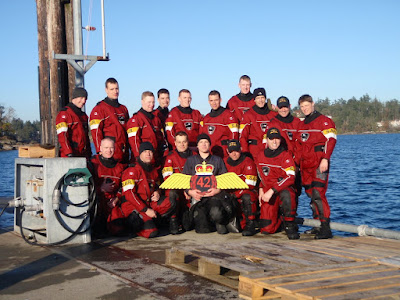We started with 5 guys doing full kit static line jumps from the Buffalo 3000' AGL so the crowd could see what we wear when we jump as well as the actual exits. The second group in the skyvan did a 4200' hop'n pop since we couldn't get the ceiling for anything higher. I was in this group and I have to admit it was a friggin' blast! When we started learning how to parachute we were jumping static line from 5000 feet and now here we were doing a freefall from almost 1000 feet lower! It was a rush. The last group of free fallers in the Buffalo managed to get up to 10,000 feet and do a legit freefall.
After landing we all 'high fived' and that stuff, field rolled our shoots and proceeded to the parade area. It is in my honest opinion that SAR Techs have the coolest grad in the forces. Your family is brought out to the seating area and they are flanked by a CC-115 Buffalo on their right and a CH-149 Cormorant on their left. The students and staff land their canopies 100 feet in front of them and parade less than 50 feet in front. We line up in 3 ranks, the first two being students with their blue berets and sans SAR wings. The third rank consists of SAR instructors. When you get called you march up to the reviewing officer, the Chief and, the course NCO where they give you your wings, orange beret and promote you.
All in all it was a pretty good day!












